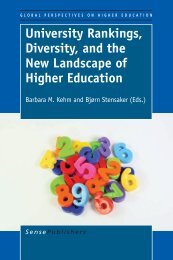Rupturing Concepts of Disability and Inclusion
Rupturing Concepts of Disability and Inclusion
Rupturing Concepts of Disability and Inclusion
Create successful ePaper yourself
Turn your PDF publications into a flip-book with our unique Google optimized e-Paper software.
CHAPTER 1<br />
anomalies <strong>of</strong> accepted norms which include somatic anomaly, spiritual anomaly,<br />
scientific anomaly <strong>and</strong> social anomaly. The authority <strong>and</strong> orthodoxy <strong>of</strong> this gaze<br />
contributing to the ‘disability dynamic’ is challenged for authenticity. 33<br />
Peter Clough <strong>and</strong> Len Barton reflect the power <strong>of</strong> such a gaze when they discuss<br />
who people with disability are:<br />
8<br />
They are the recipients <strong>of</strong> powerful pr<strong>of</strong>essional categories. These envelope<br />
their identities. They are the ‘lunatics’, the ‘idiots’, the ‘mentally h<strong>and</strong>icapped’,<br />
the ‘subnormal’ the ‘spastics’, the ‘cripples’ <strong>and</strong> ‘level-one child’. The point is:<br />
We know who They are. They are conspicuous, because their world is set about<br />
with a particularly forceful categorical thinking. (Authors’ emphases) 34<br />
Australian writers, Jan Branson <strong>and</strong> Don Miller also elaborate:<br />
The ‘disabled’, a marginalized group whose failures to satisfy the culturallyspecific,<br />
historically-specific st<strong>and</strong>ards <strong>of</strong> physical or behavioural ‘normality’,<br />
display ‘h<strong>and</strong>icaps’, inabilities to deal ‘effectively’ as individuals, with life in<br />
Western capitalist society, their ‘h<strong>and</strong>icaps’ dem<strong>and</strong>ing, in the eyes <strong>of</strong> those<br />
for whom they are an ‘other’, a policy, an objective, clearly-formulated,<br />
bureaucratically-realizable, logical, coherent approach to dealing with/coping<br />
with, their ‘h<strong>and</strong>icaps’. 35<br />
Exclusion, as a negative practice or a negative process <strong>of</strong> action, in the context <strong>of</strong><br />
intellectual disability, takes many forms <strong>and</strong> wears many disguises. Responses to<br />
the common ethical questions <strong>of</strong> ‘What ought I/we to do?’ or ‘What should I/we<br />
do?’ have evoked normative processes <strong>of</strong> exclusion throughout history such as<br />
exemption, extermination, expulsion <strong>and</strong> incarceration. In contemporary Australian<br />
society, there is little recognition <strong>of</strong> the similarity <strong>of</strong> these actions to those enacted<br />
upon Indigenous Australians. This research seeks to explore the ethical significance<br />
<strong>of</strong> inclusion, though, from wider, more critical perspectives, which will account for<br />
‘ethics’ being expressed in a somewhat negative context for people with intellectual<br />
disability. Implicit immorality in a disability context, remains to a large extent,<br />
concealed. Therefore, expressions <strong>of</strong> shame <strong>and</strong> disgust appear to be rarely<br />
articulated in relation to the historical <strong>and</strong> contemporary dislocated experiences <strong>of</strong><br />
people with intellectual disability.<br />
One reason for such omissions may be a failure to underst<strong>and</strong> the particularity<br />
<strong>of</strong> such a context. Although it is seemingly critical to note the similarities <strong>of</strong> the<br />
situations, it is also imperative to note significant differences. It could be that an<br />
Ethic <strong>of</strong> Normalcy <strong>and</strong> an Ethic <strong>of</strong> Anomaly have been enacted differently in<br />
certain contexts <strong>and</strong> that the Selvedges <strong>of</strong> Definition have different powers <strong>of</strong><br />
discernment. These differences can be illuminated by narratives about the lives <strong>of</strong><br />
people with intellectual disability, as has been articulated in the account <strong>of</strong> Angela,<br />
Trudy, Simon, Desmond, Wally <strong>and</strong> Roslyn.<br />
It appears that Indigenous children were removed from their families <strong>and</strong><br />
communities to facilitate ‘social life’ by assimilating them to the values <strong>and</strong><br />
lifestyles <strong>of</strong> white European society, <strong>and</strong> therefore facilitating ‘cultural death’.<br />
Indigenous children, with genealogical characteristics, were actively removed from














